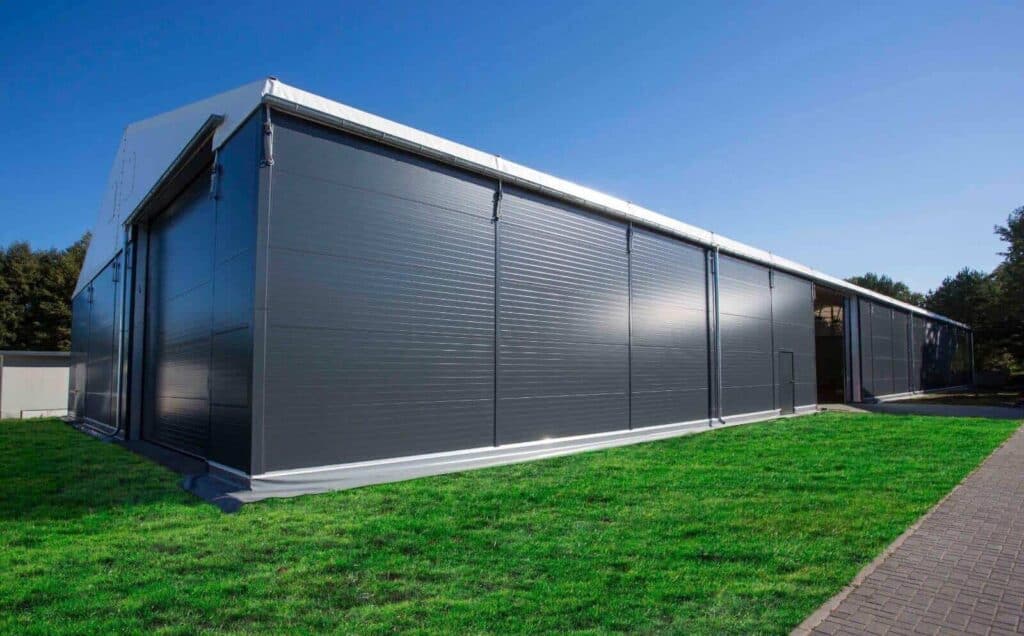Comparing Timelines: Traditional vs. Temporary Warehouse Construction
Conventional Warehouse Construction: An Extensive Endeavour
In recent years, the demand for efficient warehousing solutions has increased significantly, with more businesses seeking large warehouses to strategically place products throughout the country. This need has led to a comparison between traditional warehouse construction and temporary warehouse structures. Instant Space’s analysis of these two construction methods reveals striking differences in timelines, costs, and flexibility.
The construction process of a conventional warehouse is typically segmented into a five-step procedure: obtaining a quote, securing drawing approval, executing detailing, managing production and shipping, and undertaking physical construction. This multi-phase process is inherently time-consuming, with each stage potentially extending over weeks or even months.
Obtaining a Quote: The initial stage of procuring quotations for traditional warehouses can span up to three weeks, especially for complex projects.
Initial Planning: This phase, which encompasses both preliminary and detailed drawings, might stretch from 1 to 12 weeks, depending on the intricacy of designs.
Plan Finalisation: Detailing, involving precise construction drawings, can add another 1 to 8 weeks to the timeline.
Production and Shipping: The fabrication and transportation of pre-engineered metal building components usually take around three weeks.
Construction: This final and most prolonged phase ranges from 2 to 8 months, subject to delays caused by weather conditions, labour shortages, or design modifications.
Collectively, the construction of a traditional warehouse could extend from several months to over a year, influenced by factors such as design complexity, scale, and external elements like supply chain disruptions.
Temporary Warehouse Structures: An Expedited Alternative
In contrast, temporary warehouses offer a swifter construction alternative. These structures are predominantly composed of lightweight materials such as steel and fabric and are designed for quick assembly and dismantling.
Rapid Construction: Remarkably, temporary warehouses can be erected within a mere 6 weeks from the quotation to completion.
Cost Efficiency: Constructing these structures is approximately 70% less expensive than traditional buildings, with substantially reduced maintenance expenditures.
Adaptability: Their modular nature allows for easy expansion, relocation, or alteration, aligning with evolving business requirements.
Environmental Sustainability: Temporary warehouses are frequently constructed using efficient techniques that minimise waste and are predominantly recyclable post-lifecycle.
Customisation: Companies such as Field and Lawn enable clients to effortlessly design their temporary warehouses, diminishing the necessity for extensive consultancy services.
The construction of temporary warehouses also involves reduced complexities regarding site preparation, and they can be customised for specific requisites like temperature-controlled storage or accommodating sensitive goods.
Expanding on the Benefits and Applications
Temporary warehouse structures not only provide rapid assembly but also offer a range of benefits that are especially appealing in the fast-paced commercial world. These structures are ideal for businesses undergoing rapid growth or requiring seasonal storage solutions. Additionally, they can serve as emergency storage facilities during unexpected demand surges or as interim solutions during permanent warehouse renovations.
In terms of applications, temporary warehouses have been successfully utilised in diverse sectors including retail, manufacturing, logistics, and even in event management for large-scale, temporary storage needs. Their versatility allows for integration with advanced technologies such as automated picking systems, ensuring they are not just quick fixes but are capable of supporting sophisticated logistical operations.
Conclusion
The comparative analysis between traditional and temporary warehouse constructions positions the latter as a significantly faster, more cost-effective, and versatile solution. While conventional warehouses might be preferred for long-term, heavy-duty storage, temporary structures offer unparalleled flexibility and expediency, making them an ideal choice for businesses needing swift expansion of storage capabilities. Instant Space, acknowledging these advantages, endorses temporary warehouses as a practical alternative for businesses aiming for quick and efficient expansion in their storage and distribution networks.

